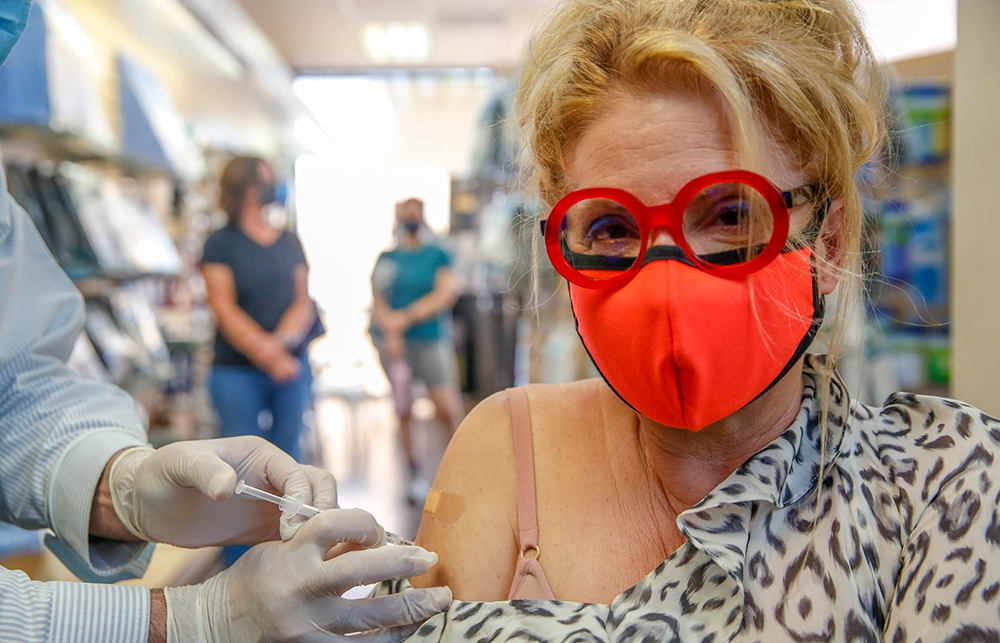
Delta变种暴露了仅用疫苗来结束新冠疫情的风险。而最糟糕的还在后头。
以色列和欧洲的几个国家(有些国家的疫苗接种率比美国高)正经历着自疫情开始以来最高的感染水平。住院和死亡人数正在逐步增加,其中包括不少已接种疫苗的人。封锁措施重新实施。在整个新冠期间,美国落后于这些国家约一个月。感恩节聚会可能会使这一时间线提前几周到来。
感染、住院和死亡人数的增加或由于疫苗接种者和曾经受感染者的免疫力下降,以及Delta和Delta-plus变种。
紧急需要增加疫苗的获取、接受和生产(包括在低收入国家),并为所有人提供加强针——这对于控制即将到来的感染、住院和死亡的浪潮而言,至关重要。拜登·哈里斯政府一直是全球领导者,但还有更多工作要做。在世界范围内,只有43%的人口得到了全面的疫苗接种。在拥有13亿人口的非洲,疫苗覆盖率还不到10%。
但是,只接种疫苗的策略注定要失败。Delta病毒的繁殖速度如此之快,以至于当一个受感染者的免疫系统岗启动时,病毒可能已经传播给其他人。这一事实,加上疫苗推出之缓慢,是灾难的根源。和所有的病毒一样,SARS-CoV-2每次繁殖时都会发生变异。如果发生的变异逃避了疫苗的保护作用,它就更有可能在接种疫苗的人身上繁衍。Delta的出现让该病毒在全球各地接种疫苗和未接种疫苗的人之间自由穿梭,大大增加了它“逃避”疫苗效力的几率。
换句话说,在未来几周和几个月内,随着另一波疫情潮到来,很有可能出现对当前疫苗具有耐药性的变异。
应对变种的新疫苗可以相对较快地生产出来。但整个过程必须包括生产、分发和接收。正如全球疫苗覆盖率的现状所表明的那样,这相当于“在公共卫生领域追赶你的尾巴”,几乎是徒劳。
因此,现在迫切需要一种易于使用的治疗方法,对所有当前和潜在变异均有效,并可显著减少传播。最近有报道称,两种药物分别将高危人群的住院率和死亡率降低了50%和89%,这是一个重大进展。然而,这些药物需要每天服药两次,且持续五天。而且由于这些产品通过血液发挥作用,它们和疫苗一样不太可能阻止受感染的人传播病毒。
为了回到疫情前的状态,我们需要采取综合办法。首先,在重返工作岗位时,以及在包括公共交通在内的任何拥挤环境中接触时,应要求每六个月进行一次疫苗强化。在很大程度上,这是因为许多人都是通过这种方式去上班。
第二,应在工作场所和其他社会环境中实施保持距离、戴口罩等公共卫生措施。
第三,在可能的情况下,应安排工作场所和其他环境,来限制人们处于他人直接气流中的时间。感染风险主要由病毒的数量和接触时间决定,这些都可能受到气流的影响。口罩、距离和接触或是防止病毒传播的有效方法。
第四,在病例激增期间,在工作场所、学校和其他社会环境中进行间隔检测,并迅速转诊和获得现有治疗。这或许有助于减少患病、住院和死亡。
最后,急需开发、生产和分发对所有变种都有效的新型、易于使用的疗法。这种疗法可能通过吸入给药。它具有三重好处:限制住院和死亡以及感染的传播;并提供六个月或更长时间的感染保护。最后一点很重要。如果吸入疗法能够像疫苗一样长时间地预防任何变体的感染,我们就有可能控制疫情发展,并结束疫情。包括我们在内的其他人正在研究能够实现这些目标的产品。
美国国家卫生研究院(National Institutes of Health)最近启动了大流行病抗病毒药物计划(Antivirals for Pandemics Program),以加速开发针对新冠和其他可能造成全球灾难的病毒的新型疗法。但这还不够。拜登政府应紧急扩大Warp Speed项目,并领导一项全球倡议,开发、确保全球获得三重威胁疗法。当然,在全球范围内提供易于使用的诊断测试的同时,还必须提高水平。
精心挑选的干预措施不会起作用:现在是采用洗碗槽策略的时候了(指宁滥勿缺、将手边一切可得资源都投注其中,编者注)。如果我们现在就采取行动,我们就有机会在未来两到三年内,在激增周期和新的疫苗耐药变异中,度过艰难但经济运行与一切如常的时期。如果我们在这段时间内实现三重威胁疗法,这场全球噩梦可能最终会结束。
不能再浪费时间了。(财富中文网)
本文作者之一Mark Dybul是Enochian BioSciences公司的首席执行官兼乔治敦大学医学中心的医学教授。他是总统艾滋病紧急救援计划和全球抗击艾滋病、结核病和疟疾基金的前负责人,也是大流行病准备和应对独立小组的前成员。
本文作者之一Serhat Gümrükçü是Seraph Research Institute的创始人和执行董事,也是Enochian BioSciences的联合创始人。
编译:杨二一
Delta变种暴露了仅用疫苗来结束新冠疫情的风险。而最糟糕的还在后头。
以色列和欧洲的几个国家(有些国家的疫苗接种率比美国高)正经历着自疫情开始以来最高的感染水平。住院和死亡人数正在逐步增加,其中包括不少已接种疫苗的人。封锁措施重新实施。在整个新冠期间,美国落后于这些国家约一个月。感恩节聚会可能会使这一时间线提前几周到来。
感染、住院和死亡人数的增加或由于疫苗接种者和曾经受感染者的免疫力下降,以及Delta和Delta-plus变种。
紧急需要增加疫苗的获取、接受和生产(包括在低收入国家),并为所有人提供加强针——这对于控制即将到来的感染、住院和死亡的浪潮而言,至关重要。拜登·哈里斯政府一直是全球领导者,但还有更多工作要做。在世界范围内,只有43%的人口得到了全面的疫苗接种。在拥有13亿人口的非洲,疫苗覆盖率还不到10%。
但是,只接种疫苗的策略注定要失败。Delta病毒的繁殖速度如此之快,以至于当一个受感染者的免疫系统岗启动时,病毒可能已经传播给其他人。这一事实,加上疫苗推出之缓慢,是灾难的根源。和所有的病毒一样,SARS-CoV-2每次繁殖时都会发生变异。如果发生的变异逃避了疫苗的保护作用,它就更有可能在接种疫苗的人身上繁衍。Delta的出现让该病毒在全球各地接种疫苗和未接种疫苗的人之间自由穿梭,大大增加了它“逃避”疫苗效力的几率。
换句话说,在未来几周和几个月内,随着另一波疫情潮到来,很有可能出现对当前疫苗具有耐药性的变异。
应对变种的新疫苗可以相对较快地生产出来。但整个过程必须包括生产、分发和接收。正如全球疫苗覆盖率的现状所表明的那样,这相当于“在公共卫生领域追赶你的尾巴”,几乎是徒劳。
因此,现在迫切需要一种易于使用的治疗方法,对所有当前和潜在变异均有效,并可显著减少传播。最近有报道称,两种药物分别将高危人群的住院率和死亡率降低了50%和89%,这是一个重大进展。然而,这些药物需要每天服药两次,且持续五天。而且由于这些产品通过血液发挥作用,它们和疫苗一样不太可能阻止受感染的人传播病毒。
为了回到疫情前的状态,我们需要采取综合办法。首先,在重返工作岗位时,以及在包括公共交通在内的任何拥挤环境中接触时,应要求每六个月进行一次疫苗强化。在很大程度上,这是因为许多人都是通过这种方式去上班。
第二,应在工作场所和其他社会环境中实施保持距离、戴口罩等公共卫生措施。
第三,在可能的情况下,应安排工作场所和其他环境,来限制人们处于他人直接气流中的时间。感染风险主要由病毒的数量和接触时间决定,这些都可能受到气流的影响。口罩、距离和接触或是防止病毒传播的有效方法。
第四,在病例激增期间,在工作场所、学校和其他社会环境中进行间隔检测,并迅速转诊和获得现有治疗。这或许有助于减少患病、住院和死亡。
最后,急需开发、生产和分发对所有变种都有效的新型、易于使用的疗法。这种疗法可能通过吸入给药。它具有三重好处:限制住院和死亡以及感染的传播;并提供六个月或更长时间的感染保护。最后一点很重要。如果吸入疗法能够像疫苗一样长时间地预防任何变体的感染,我们就有可能控制疫情发展,并结束疫情。包括我们在内的其他人正在研究能够实现这些目标的产品。
美国国家卫生研究院(National Institutes of Health)最近启动了大流行病抗病毒药物计划(Antivirals for Pandemics Program),以加速开发针对新冠和其他可能造成全球灾难的病毒的新型疗法。但这还不够。拜登政府应紧急扩大Warp Speed项目,并领导一项全球倡议,开发、确保全球获得三重威胁疗法。当然,在全球范围内提供易于使用的诊断测试的同时,还必须提高水平。
精心挑选的干预措施不会起作用:现在是采用洗碗槽策略的时候了(指宁滥勿缺、将手边一切可得资源都投注其中,编者注)。如果我们现在就采取行动,我们就有机会在未来两到三年内,在激增周期和新的疫苗耐药变异中,度过艰难但经济运行与一切如常的时期。如果我们在这段时间内实现三重威胁疗法,这场全球噩梦可能最终会结束。
不能再浪费时间了。(财富中文网)
本文作者之一Mark Dybul是Enochian BioSciences公司的首席执行官兼乔治敦大学医学中心的医学教授。他是总统艾滋病紧急救援计划和全球抗击艾滋病、结核病和疟疾基金的前负责人,也是大流行病准备和应对独立小组的前成员。
本文作者之一Serhat Gümrükçü是Seraph Research Institute的创始人和执行董事,也是Enochian BioSciences的联合创始人。
编译:杨二一
The Delta variant has laid bare the dangers of a vaccine-only approach to ending the COVID-19 pandemic. And the worst is yet to come.
Israel and several countries in Europe—some with greater vaccination coverage than the U.S.—are experiencing the highest levels of new infections since the beginning of the pandemic. Hospitalizations and deaths, including among vaccinated and younger persons, are creeping up. Lockdowns are being reimposed. Throughout COVID-19, the U.S. has trailed behind those countries by about a month. Thanksgiving gatherings might accelerate that timeline by a few weeks.
The increase in infections, hospitalizations and deaths could be attributed to waning immunity in vaccinated and previously infected persons, and to Delta and Delta-plus variants.
Urgently increasing vaccine access, acceptance, and production, including in lower-income countries, with boosters for all, is essential to limit the coming tide of infections, hospitalizations and deaths. The Biden-Harris administration has been a global leader, but much more needs to be done. Worldwide, only 43% of the population has been fully vaccinated. In Africa—home to 1.3 billion people—the coverage rate is less than 10%.
However, a vaccine-only strategy is doomed to fail. Delta reproduces so rapidly that by the time an infected person’s immune system kicks in, the virus could have already spread to others. That fact, combined with the slow rollout of vaccines, is a recipe for disaster. Like all viruses, every time SARS-CoV-2 reproduces, it mutates. If a mutation occurs that evades the protective effect of vaccines, it is more likely to thrive in a vaccinated person. With Delta, the virus freely ping-pongs between vaccinated and unvaccinated people across the globe, significantly increasing the odds that it will “escape” the effectiveness of vaccines.
In other words, as another wave hits in the coming weeks and months, there is a high probability that variants will emerge that are resistant to current vaccines.
New vaccines to counter variants can be produced relatively quickly. But they must be produced, distributed, and received. As the current state of global vaccine coverage demonstrates, that is the public health equivalent of chasing your tail.
An easy-to-use treatment that is effective against all current and potential variants and that also significantly reduces transmission, is desperately needed. Recent reports of two drugs that decreased hospitalization and deaths in persons who are at high risk by 50% and 89%, respectively, is a significant advance. However, those drugs require twice-daily pills for five days. And because the products work through the bloodstream, they are as unlikely as vaccines to stop infected people from spreading the virus.
To get back to business as usual, we need a combined approach. First, vaccine boosters every six months should be required for return to work, and for contact in any crowded setting including public transportation—in no small part because that is how many people get to work.
Second, distancing, masking and other public health measures should be enforced in the workplace and other social settings.
Third, where possible, workplace and other settings should be arranged to limit the duration persons are in the direct airflow of others. Infection risk is largely determined by the amount of virus and the duration of exposure, which can be affected by airflow. Masks, distance and exposure could be an effective way to prevent spread of the virus.
Fourth, during surges, interval testing in the workplace, schools and other social settings, with rapid referral and access to existing treatments, should help reduce illness, hospitalization, and death.
Finally, an urgent effort is needed to develop, produce, and distribute novel, easy to use therapies that are effective against all variants, likely administered by inhalation, with triple benefits: limiting hospitalizations and deaths and the spread of infection; and providing protection from infection for six months or more. That last piece is important. If inhaled therapies could prevent infection with any variant for as long as vaccines, we could potentially advance from controlling the pandemic to ending it. We and others are working on products that could achieve those objectives.
The National Institutes of Health recently launched the Antivirals for Pandemics Program to accelerate the development of novel treatments for COVID-19 and other viruses that could cause another global catastrophe. But more is required. The Biden administration should urgently expand Project Warp Speed and lead a global initiative to develop and ensure global access to triple-threat treatments. Of course, global availability of easy-to-use diagnostic tests must be simultaneously advanced.
Cherry-picking interventions will not work: Now is the time for a kitchen-sink strategy. If we act now, we have a shot at a rough but business-as-usual-adjacent ride through cycles of surges and new vaccine resistant variants through the next two to three years. If we achieve triple-threat therapies during that time, this global nightmare could finally end.
There is no time to lose.
Mark Dybul is CEO of Enochian BioSciences and professor of medicine, Georgetown University Medical Center. He is a former head of the President’s Emergency Plan for AIDS Relief and the Global Fund to Fight AIDS, Tuberculosis and Malaria and a former member of the Independent Panel on Pandemic Preparedness and Response.
Serhat Gümrükçü is the founder and executive director of Seraph Research Institute and co-founder and inventor of Enochian BioSciences.






